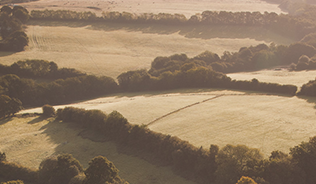At the end of 2020, the IES set out the work we will be doing ahead of COP26 to bring together expert voices on climate science. Across six themed discussions, the IES is using its platform to generate conversations and to clarify key areas of consensus and conflict which will need to be addressed ahead of the conference this November.
As we reach the end of the first of our ‘STAGES on the Road to COP26’, we approached the discussion from that high level starting point: when it comes to climate action and broader issues of sustainability, where are the synergies and trade-offs, and how should we approach the work ahead?
Key ideas to take away from the first discussion event
The culmination of the first stage was a discussion event with a presentation by Professor Chris Rapley, followed by reflections in a series of breakout groups, looking at the trade-offs and synergies between climate action and sustainability, the ways we can create truly green societies, and the respective roles of developed and developing countries. The event opened with Rapley taking attendees on a tour of some of the most prevalent theoretical frameworks surrounding sustainability; from Jay W. Forrester’s analysis of multi-loop nonlinear feedback systems in the 1970s to Kate Raworth’s 2017 work, Doughnut Economics.
The message was clear: social systems are complex and interconnected. These systems must be approached with an appropriate level of understanding, and we must urgently find a way to balance human needs with the limits of the natural world. Acknowledging the extent of that challenge, Professor Rapley set out the scale of what that means: the 17 Sustainable Development Goals comprise 169 targets and the 164 Nationally Determined Contributions of the 2015 Paris Climate Change agreement cover more than 7000 actions. Effectively integrating these into national policies, strategies and planning, in a coherent and synergistic manner, will pose a monumental challenge. However, it is essential that these are addressed in tandem through complementary policies and action.
A number of themes arose from the discussion which followed, and these are the questions which will need to be addressed as we continue our conversations on the road to COP26.
How do we manage the inevitable trade-offs and what should we prioritise?
The first question was naturally the one capturing the highest level of discussion, and it's a theme which will continue to run through all conversations about long-term climate action, especially in the months ahead of COP26. In pursuit of balance, Professor Rapley suggested Karl-Henrik Robèrt's The Natural Step as a source of fundamental principles to observe: when digging anything deleterious out of the ground or synthesizing anything deleterious, you should control it at its source rather than dealing with its symptoms; don't 'take a chainsaw to the biosphere' which we rely on for human survival; and as a priority, pursue human equity and decent standards of life. Those principles will inevitably play a core role in the discussions to come, though the specifics of how to put them into action while tackling the challenge ahead will still be a subject for further debate.
What should be the role of the profession and professional bodies?
Another key area of thought posed by the event was where environmental professionals and professional bodies like the IES fit into the picture. There was broad agreement that professional bodies need to reflect the social dimensions of their membership, and that the climate science community has much to offer to wider public debate. One of the fundamental challenges of the time between now and COP26 will be to re-evaluate the historic roles science has had in conversations about climate change, especially with governments and the public. With such a significant amount of work to be done, the IES should use its convening power to support conversations and shape the search for solutions. This will help to ensure that these crucial decisions are made based on a robust understanding of scientific evidence and its implications for society.
How can we make climate action and sustainability relevant to the wider public, and how can we ensure that policy makers are informed by sound science?
The discussion also focussed on the practical side of these inevitable conversations. Major barriers are posed by the accessibility of science, the willingness of companies and individuals to make major changes to how they work and live, and the way that environmental policies have historically been viewed in the political sphere. Much progress has been made over the last 30 years, but with increasing pressure to act quickly, and the significant opportunity of COP26 which cannot be squandered, it is important that the wider public is able to relate to the issues at hand on a personal level. There are still outstanding questions about how to make issues of sustainability relevant and engaging to all communities, but fundamentally the question that we need to ask is: 'What story are we trying to tell and how can we inspire others to take action?'
What comes next?
While these discussions and debates continue to play out in the professional community, the IES is already working to bridge the gap between science and public understanding. Today we are launching our briefing paper on The Sustainable Development Goals and Climate Change, seeking to make clear the synergies and challenges which exist in our work towards sustainable development while also pursuing robust climate action.
The last key point to take away from this is that many of these trade-offs will require action which moves us away from unsustainable systems of consumption and production which have become ingrained in our society. Following from that, the IES will be looking into key questions of transformative change as we enter the second of our STAGES on the Road to COP26: 'Transformation'. You should expect to hear more soon about our plans for this crucial discussion, where we will be taking a more direct look at systems which require transformation and the ways we can promote societal change.





